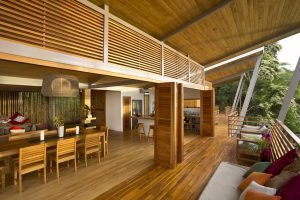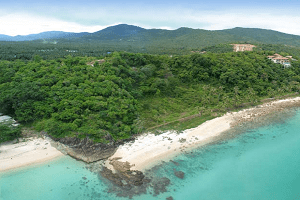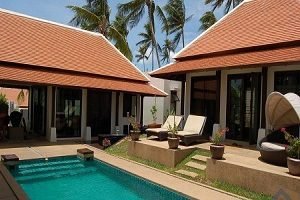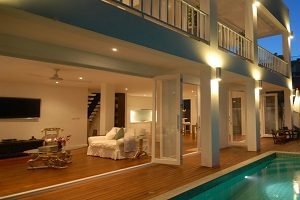|
Ko Samui (เกาะสมุย), (pronounced gaw (vowel like ou in cough) sà mui) is an island located in the Chumphon Archipelago in the Gulf of Thailand, some 700 km south of Bangkok and about 80 km from the eastern coastline of Southern Thailand. Understand[edit]An island of natural beauty and variety, Samui is home to about 40,000 full-time inhabitants, 90% of whom are Buddhist. The palm-fringed shoreline and coconut and fruit cultivation of the coastal lowlands rise to a central granite massive, the slopes of which are cloaked in virgin rainforest. At 247 km² Samui is the second-largest island in Thailand and the largest island in the Chumphon Archipelago of over 80 (mostly uninhabited) islands which form the Ang Thong National Marine Park, a kayaking and snorkelling paradise. At 25 km long and 21 km wide, Samui is big enough for serious exploration by the adventurous and fit, but can be circumnavigated in just a couple of hours by motorbike or car. The island was probably first inhabited about 15 centuries ago, settled by fishermen from the Malay Peninsula and southern China. It appears on Chinese maps dating back to 1687, under the name Pulo Cornam. The name Samui is mysterious in itself. Perhaps it is an extension of the name of one of the native trees, mui, or it is a corruption of the Chinese word Saboey, meaning “safe haven”. Until the late 20th century, Samui was an isolated, self-sufficient community, having little connection with the mainland of Thailand. The island was even without roads until the early 1970s, and the 15 km journey from one side of the island to the other involved a whole-day trek through the mountainous central jungles. In the early 1970s the first backpackers travelling on the back of a coconut boat arrived on Ko Samui. For years after that the island had just a few bungalows and a trickle of tourists. Things started to change in the early 1990s when tourists started arriving on full boats and since then the place has grown substantially. Samui is now the second-most popular place as an island destination in Thailand (the first is Phuket). Undeservedly so. The water on most of the beaches of Ko Samui is often murky and the most popular streets of Ko Samui are dirty and filled with pushy promoters. Unfortunately, development on Ko Samui is starting to take its toll and it is far from a paradise island now. Climate[edit]
Samui’s weather patterns are a little different from the rest of Thailand. In April through September, when most of the country has its monsoon, Samui stays fairly dry, but from October to December, it’s wet in Samui and drier elsewhere. The driest season is from January to March. Get in[edit]A 300 baht surcharge is levied on domestic departures, as well as the 500 baht surcharge on international departures. If you fly via Bangkok to an international destination, the tax is only 200 baht as the Bangkok International departure tax is already included in your ticket. As of November 2013, these charges are included in the ticket price. By plane[edit]Ko Samui Airport (USM) is a private airport originally built by Bangkok Airways [8], which is still the main operator and was for a long time the only airline with services to Ko Samui. They have near-hourly departures to/from Bangkok and tickets are expensive by Thai standards, with advance bookings costing 3,000-4,500 baht one-way, while a walk-in booking may be twice as much. There are also daily flights to/from Phuket for 2,000-3,000 baht. Two daily flights from Chiang Mai (but only one direct flight in the opposite direction). A feature of the international departure gate is a courtesy corner which provides food and drinks for all passengers in a cosy sitting area. Awaiting boarding becomes rather comfortable with food, drinks, and Wi-Fi provided. In addition to Bangkok Air, Ko Samui is served by two flights a day from Bangkok with Thai Airways as well as by Berjaya Air [9] and Firefly [10] from Subang airport (a small city airport 30 minutes from Kuala Lumpur city centre), and Penang International Airport in Malaysia. Visa-on-Arrival and Visa-Free entries are available at Samui Airport for some nationalities. See Thailand for more information. Ground transportation from the airport is readily available. A seat on a mini-bus for the 20-minute ride to Chaweng costs 120 baht/person; a faster private mini-bus will cost 400 baht upwards. There are no real Taxis at the airport, and since many drivers refuse to use their meters you will probably pay the same if your try to get a Taxi outside the airport. If you’re a couple or a family, you’ll probably be approached by some young women holding up signs for some of the higher-end hotels. They will ask you where you’re staying, and based on the answer, offer you a free taxi ride if you promise to attend a presentation for their hotel’s time share during your stay (avoid the offers). Alternative airports Other airports to fly into Ko Samui include Surat Thani Airport and Chumphon Airport on the mainland with good ferry connections to Ko Samui. These are often significantly cheaper and are served by excellent low cost carriers Air Asia and Nok Air.
By boat[edit]From Chumphon via Ko Tao, Ko Phangan Lomprayah [11] offers a combined bus/high speed catamaran ferry service from Bangkok to Ko Samui which takes about 11 hours (5.5 of them by boat) and costs around 1,250 baht (1,000 baht in the opposite direction). The bus pauses in Hua Hin and then stops at Chumphon, where it connects with the ferry, which calls at Ko Nang Yuan, Ko Tao and Ko Pha Ngan on its way to Ko Samui. While the route may be more scenic (as includes the longboat trip via 2 islands), and the ferry itself is comparable to Seatran, the entire trip to Samui will take more time but provides a good way to see both the countryside and islands. An option to the bus trip is a 50 minute flight from Bangkok to Chumphon Airport via Nok Air and transfer to the high speed ferries stopping at Ko Tao along the route. Lomprayah high speed catamarans are good and fast option to get to Samui from Ko Tao or Ko Phangan, as well as a reasonable way to get to those islands from Bangkok. There are also regular speedboats and ferries of other operators. From Surat Thani Both train station and Surat Thani Airport (URT), there are combined bus/ferry services to Ko Samui for 200-300 baht. Some entail a 60-minute bus ride to Donsak pier followed by a 90-minute ferry crossing. Others a 30-minute bus ride, but the ferry takes extra time. Tickets are sold by numerous agents that meet each train and airport. (Please read the “scammers” listing in Surat Thani article if you want a fair price, otherwise you will pay double) The cost should certainly be less than 300 baht, even if bought this way (return combo boat + bus ticket on more comfortable Seatran ferry bought on the Nathon pier on Samui officially costs 230 baht). From Donsak pier, there are 2 ferry companies (departures every 30-60 mins) which terminate at Nathon Pier: Songserm Travel [12] and Seatran ([13]. The first one is what you more often get if booking via the travel agency. It’s a rather small ferry with two decks, often very crowded so you can’t get the seat on the lower one if you come late. The upper deck, while air-conditioned, costs extra, so you may end up sitting around the pile of backpacks on the back of the boat under the sun if you do not want to pay). There is a small on-board shop on the lower deck, but the prices are grossly inflated (instant noodles, which cost 15 baht in a 7-11, are sold for 50 baht on-board). If you choose this boat, bring your own snacks. The people aboard Songserm ferry are mostly, if not all, foreigners. Seatran ferry is much bigger, and has several decks (entrance to most of the those, including air-conditioned areas, is free), much less packed just because of size (still can be at peak times of high season), and is equipped with numerous TVs (Thai channels). It has a big cafeteria (with much friendlier prices, such as 20 baht for the same cup of noodles), and the passengers are mostly Thai, as well as some expats and tourists. Their schedule can be found here [14] (the first list is departures from Donsak to Samui, the second is return). Raja Ferry Port [15] operates services between Donsak pier and Lipa Noi Pier on the western side of Samui (several kilometres south of Nathon). It includes a free air conditioned deck and comfortable seats. This ferry also transport cars, so can be used should you decide to come with your own transport. No Songthaews or taxis were seen there at Feb 2017, but there were minibuses which will apparently take you where you want to go for a price. The pier is three kilometres from the main road so your options are limited. Numerous ferry services are direct from mainland Surat Thani including an express boat (3 departures daily, taking around 3 hours and costing 150 baht) and slow night boats (taking 6-7 hours). Call operator Songserm Travel (+66 25 29 654 in Bangkok)[16] for the latest schedules, which varies according to the season. Get around[edit]As on many islands in Thailand, motorbikes are available for rent. Compared to other nearby islands, Samui’s road system is very developed and there are plenty of taxis cruising about, although it’s a challenge to get them to use their meters. Taxi[edit]The Samui Taxi is a public taxi service. The drivers, however, are very reluctant to use their meters (unlike in Bangkok), and, especially on popular beaches or entry points to the island, tend to ask foreigners much more than normal fare. Some, say on Nathon pier, will even show you official-looking papers with “fixed” prices like 600-800 baht for a 25-30 km trip to Chaweng or Lamai beach. This is not true, and once they know you’re aware of that, it’s usually possible to bargain (for this distance, you should bargain to at least 400 baht, or even better, 300 baht, which is still higher than Bangkok metered taxi prices). On the popular beaches it may be impossible at all to get a reasonable fare sometimes. If so, just walk to some area which is more quiet and far away from luxurious hotels. NaviGo Samui is a Mobile taxi application similar to that of Uber and GrabTaxi in the west. Taxi can be ordered quickly once the app is downloaded and waiting times are rarely over 5 – 10 minutes. The fares are strictly metered and an estimate of the total fare can be seen before confirming the order. All taxis have cameras inside and the drivers speak good English. The service is a good, safe alternative to the regular Taxis to avoid unreasonable fares. At least on a public holiday, don’t expect there to be any NaviGo drivers to pick you up from the airport. Airport taxi & transfer[edit]There is a taxi counter after the arrival hall at Samui Airport. However, queuing and waiting for the service is quite annoying. There are other taxis waiting behind the counter, but the price is either the same or mostly higher. It is probably best to book your taxi or minibus in advance online. There is a reliable provider such as Samui Taxi [http//:www.SamuiTaxi.com] which charges 440 baht to Chaweng and they wait for their clients at the meeting point. By bus[edit]Pickup trucks/public passenger pick-up vehicles (songthaews) also serve as group taxis. To get from the Nathon Pier to Bophut/Chaweng take a brown one which runs at regular intervals and will cost 50 baht to or from Bophut (do NOT negotiate a fare unless you want a taxi situation as these are the way in which the locals get around. Just ask if he is going that way and get on board. If you want to go to a particular place, then hire a taxi or songthaew and negotiate the price with them first. To get to Lamai, in the opposite direction, costs B70. Is also brown in colour. The songteows go from close to the pier in each direction. Strangely, you can only get to Chaweng in one direction, and Lamai in the other. To go from one to the other requires a taxi. When you want to get off, just push the buzzer in the roof, and then go to pay the driver. As of April 2014, drivers tend to demand a flat rate of B100 for any trip between 2 cities (for example Chaweng to Lamai). Be advised this is grossly inflated compared to the normal rate paid by the locals (and displayed – unfortunately in Thai only – inside the car on a small white board). There is little you can do about it but is best kept in mind if you feel like bargaining. As of Feb 2017 there are now aircon minibuses which go between Nathon and Chaweng. The fare is B100 (but they may try to get B200 out of you!) Motorbike[edit]Motorbikes can be rented virtually anywhere on Ko Samui for between 120-700 baht per day depending on the size and season (a small 125 cc scooter should cost no more than 200 baht even during New Year). It is recommended that you hire only from a reputable company as there have been reports of scams. Some places deliberately steal bikes that they have rented out. Also the motorbikes don’t have insurance. If they say they have insurance, it’s not true. If something happens, you can’t claim for it. Read the rental agreement very carefully, as too many (not typical in other parts of Thailand, e.g., Chiang Mai) will state that you may not replace any broken/damaged parts yourself. This is a scam, as they will replace the part for you for a price several times higher (sometimes also stated in the agreement) than it actually costs. They will check any old scratches and/or serial numbers, if noted in the agreement, and demand that price even if you have already replaced the part yourself! For the same reason, inspect the motorbike carefully and be sure any existing scratches/damages are written into the agreement before you have taken the motorbike. Motorbike shops will likely want you to leave your passport as a collateral. This is a common practice in Thailand, and, by itself, shouldn’t raise much concern. Most government travel advisory services advise against leaving your passport anywhere as a deposit for obvious reasons. Combined with the scams and bad practices mentioned above, however, it may lead to a situation where your passport is held as “hostage” until you pay what they want. For this reason, it’s unwise to return your motorbike just before your departure. Leave at least several hours, or perhaps a day, to settle any problems that may arise. If the shop’s demands are clearly illegitimate, (the agreement you have signed does not contain any silly conditions and prices, the price they ask for damages is unreasonable, or the damage was clearly done before you rented that motorbike), call the tourist police. If hiring a bike doesn’t appeal to you, then there are motorbike-taxis willing to take you around for a (negotiable in advance, as foreigners are commonly asked an exorbitant price) fee, as well as other modes of transportation. Electric Bikes[edit]There is also the choice of Electric Bicycles, which is a good option as there is no International licence needed & they can go a long distance without you raising too much of a sweat. At the moment they have the option of using your passport as security, or leaving a deposit, so you don’t have many of the issues raised above. Bicycles[edit]Bicycles can be hired very cheaply on Ko Samui. One shouldn’t cost more than a 200 baht per day. Car[edit]There are many car hire options on Ko Samui, including the local arms of international companies such as Budget and Avis. Prices are fairly expensive (800-1,500 baht/day for a small car), but the convenience of a small air-conditioned car may be worth it. You can pick up and drop off at the airport or some other location. Driving is easy on the island as long as you are not in a hurry. Having a car gives you easy access to almost all areas of the island. See[edit][add listing]Beaches[edit]Ko Samui is a fairly big island. The most popular and commercialised beaches are Chaweng and Lamai, while the northern beaches and their adjacent villages of Mae Nam, Bophut, Bang Rak (Big Buddha) and Choeng Mon are more peaceful choices, and the west coast beaches are still (comparatively) quiet. Clockwise from Nathon on the west coast, the main beaches are:
The major reason why people come to Samui is to enjoy the beaches. Even though the two main beaches of Chaweng and Lamai have generally suffered due to mass development over the past decade they are still decent. However the beaches of Phuket and Ko Chang have clearer water and are generally better for swimming. Development has been thwarted slightly because of the island’s regulation governing building heights. Other than lying on the beach with a cold beer in hand and ogling at the babes and hunks sauntering past, there isn’t all that much to see on the island. A certain pair of rocks on Lamai amuses some visitors, Bang Rak has a large but nondescript Buddha statue, and there are some waterfalls (notably Na Muang 2).
Other island attractions include coral beds at Laem Set and Thong Takhian; the nearby butterfly garden and aquarium; a snake farm; a monkey theatre at Bo Phut, and a massive seated Buddha image on Fan Isle.
Do[edit][add listing]
Jackie Muay Thai (Muay Thai Training in Koh Samui), 114/14 moo 6 Bo Phut Chaweng (Near the Football Area), ☎ +668-4187-7582, [1]. Muay Thai Training school in Koh Samui, owned by master Jackie also known under his fighting name Sakmongkol Monsaichon, with more than 250 fights under his belt, a former Lumpinee and Rajadammnern Bangkok champion. Open to experts and beginners. 1 training 400, 1 week from 2000, 1 month from 6000. edit
The usual panoply of watersports are available, including plenty of dive shops, but most diving is done either in the nearby Ang Thong National Marine Park or Ko Tao as the visibility around Samui’s sandy beaches tends to be poor. You can book diving day trips at dive shops, most of which are based in Chaweng. The dive boats tend to leave from the pier at Bophut and Bang Ruk. The south of Thailand has some of the most beautiful beaches and islands in the world, which are surrounded by crystal clear water and stunning coral. For this reasons the number of divers coming to Thailand has steadily increased over the past decade. Even though the best time year of the year to dive in the Ko Samui is between June and August, it is still perfectly possible to dive virtually all year round. As Thailand is considered one of the safest destinations for diving and snorkelling in the world, it is perfect for first-timers. The sea visibility in some places around Ko Samui is good (distances of up to 10-30 m). One can enjoy splendid sights of underwater mountains, coral gardens, undersea rock formations, hard and soft coral, and whale sharks when in season.
Eat[edit][add listing]
Samui is well known for its coconuts, which are available everywhere and quite tasty. Being an island, seafood is generally a good choice, although in high-season demand often exceeds local supply. The larger beaches have a number of international restaurants as well (often run by Thai-farang couples) with Bophut having a particularly good reputation. Southern Thai food in general is renowned for its spiciness. Much of the cuisine has its origins in Malay, Indonesian, and Indian food. Favourite dishes from the south include Indian-style Muslim curry (massaman), rice noodles in fish curry sauce (Khanom Jeen), and chicken birayani. Popular local food are salted eggs and rambutan, too. Dual pricing is regrettably common: some restaurants have two menus, one for tourists and the other for Thai people, at about 1/4 of the foreigner prices. Main courses in a standard, low-key Thai restaurant should be under 100 baht (except some seafood dishes). If prices seem unreasonably steep, head elsewhere. Always check prices and menu first so you don’t have to argue when the bill is delivered. Drink[edit][add listing]
There are innumerable options for a drink, ranging from the loud and brash tourist pubs and girlie bars of Chaweng to the candle-lit romantic bars of Bophut. Figure on 80 baht for a local beer (Singha, Tiger, Chang, Heineken) and up to twice as much for any import. Wine is especially expensive and usually costs over 2,000 baht per bottle. Beer bars[edit]
Chaweng Beach is especially famous for its beer bars (also called bar-beers), staffed by pretty hostesses, usually from northeast Thailand. Buy them a ‘girlie drink’ and you’ll be in entertaining company. Beer bars can be found all over Chaweng. The bars offer pool, Connect4, and other popular bar games. Since the night life on Chaweng can see serious debauchery at times, the local law enforcers are strict with regard to enforcing closing times. The official closing time in “entertainment zones” is 01:00 (in practice usually somewhere between 01:00 and 02:00, depending on the location). Nightclubs[edit]
Chaweng Beach is packed out with nightclubs playing mostly commercial, pop and electronic music and serving exotic cocktails. Karaoke[edit]At karaoke places customers can either choose a private room or sing in the main lounge for everyone to hear. There are Thai songs and international songs. There may be pretty hostesses available to sit with for a pleasant chat. These are especially popular with East Asian tourists. Rum Distillery[edit]There is a distillery that brews 5 flavours of rum on one of the side roads on the south coast of the island, which offers tours during the sugar cane season and free samples any time. The flavours are natural (sugar cane), lemon, orange, pineapple, and coconut. Natural and coconut are actually quite tasty, lemon has a very strong pleasant citrus flavour, and you won’t miss anything if you don’t try the other two. They also have a delicious mixer to serve with consisting of lime juice, cinnamon, and other spices. Worth heading to if you’re in the area, or just for the novelty of sampling authentic Thai rum. Very friendly staff. Sleep[edit][add listing]
With an estimated 60,000 rooms, accommodation should not be a problem, and the most difficult decision will be picking a suitable beach. If you’re into nightlife, Chaweng and Lamai are definitely the places to go. If you’re in for a quieter beach experience, try Mae Nam or the South Coast. A good compromise is Bophut. Choeng Mon is a good choice if you’re looking for a quiet hideaway retreat. Nathon is in the central part of the island. Mid range to luxurious villas can be rented anywhere in the island. Stay safe[edit]Tap water is generally not potable. Liquids from sealed bottles nearly always are, and should be used wherever possible. Take care in restaurants as some may use unsafe tap water to make ice for drinks otherwise made with bottled/safe ingredients. Tap water in most hotels should not be used for drinking or brushing teeth unless explicitly labeled as safe. Motorbikes are somewhat risky, but jeeps, trucks and other cars for rent are readily available at very reasonable rates, and are considerably safer. If you must use a motorbike always wear a helmet and never drive drunk the roads are hazardous with many large potholes. After a good time drinking in the party areas of Chaweng, Bophut, and Lamai, taxis are readily available to take you home. Be careful generally taxi drivers tend to rip off drunks. It’s not rare for a tuk-tuk driver to charge you 50 baht for just a kilometre journey (for example, along the main Chaweng market) during evenings. A recent development has been the appearance of quad bikes to rent for use on the roads. These do not appear to be registered for road use so take care. Be careful on beaches at night time as crimes often occur there. If travelling to Ko Samui, Ko Pha Ngan or Ko Tao by bus, do not store any valuables in your luggage. They have been reports of thefts from buses operated by “Songserm” Travel. Do not let your valuables out of your sight when transiting from the train to the islands. Contact[edit]Samui has more than its fair share of Internet cafes. The hourly charge is about 30 baht. The GSM networks of all major Thai mobile operators cover the island quite well. While roaming is an option, purchasing local SIM card will save you a lot on international calls. Even more, GPRS/EDGE service is a cheap and convenient way to access the Internet from virtually anywhere. See the main article for details. Cope[edit] |
||||||||||||||||||||||||||||||||||||||||||||||||||||||||||||||||||||||||||||||||||||||||||||||||||||||||















